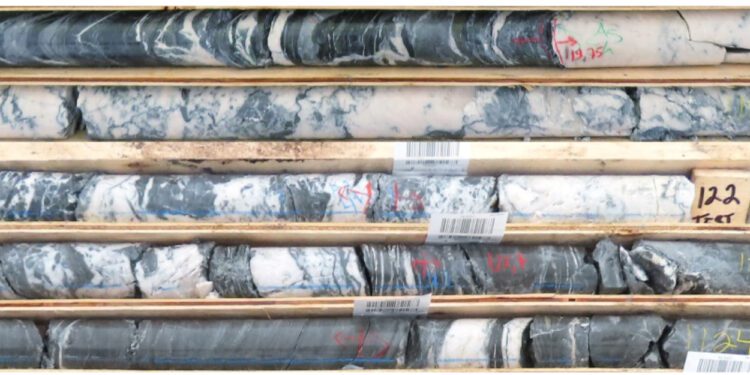Snowline Gold Corp. (CSE: SGD) has received additional promising assay results from Phase I drilling at the Jupiter zone on its district-scale Einarson gold project in the Yukon Territory, Canada.
The highlight of these results are from Hole J-21-015, which was collared 153 metres northwest of previous holes J-21-010 to J-21-013.
The hole intersected a wide, mineralised quartz-carbonate breccia which averaged 13.7 g/t Au over 3.6m beginning at 119.1m downhole.
“We are excited to intersect additional high-grade gold mineralisation in this significant step-out from our discovery holes,” said Scott Berdahl, CEO and director of Snowline. “Jupiter is a blind target – it’s close to the surface but covered by thin overburden. We did not have a mineralised discovery outcrop to trench nor to drill, so our Phase 1 holes were somewhat random tests of a blind system.
‘Nonetheless, these drill holes are regularly hitting gold, and this latest intersection further expands the footprint of known in-situ mineralisation.
“We still have a lot to learn, and have yet to delineate the length, depth or even the breadth of the gold system.
“We are eagerly awaiting assay results from the remaining five holes at Jupiter, as well as all four holes from the Valley zone on our Rogue project.”
Massive to brecciated, well-mineralised quartz-carbonate material was intersected in drill hole J-21-015 at 119.1 m downhole, containing grey siltstone fragments and intercalated siltstone layers.”
Well-developed acicular arsenopyrite crystals (up to 10% locally) occur in and near stylolites in quartz, within mineralized siltstone fragments and in vein selvages. Pyrite occurs as medium to coarse grained crystals in quartz and host rocks. The highest gold grades occur towards and within the margins of the vein system.
Hole J-21-016 was collared from the same drill pad as J-21-015 but drilled at a steeper angle. Assays have been received for the top 174 m of this 233 m hole, while assays below this remain pending.
Holes J-21-008 and J-21-014 were drilled in the vicinity of earlier holes (J-21-001 to J-21-007 and J-21-009) and they both intersected zones of altered siltstone, and minor mineralized quartz-carbonate veins. J-21-008 intersected quartz veins around a sulphide-bearing fault zone that assayed 1.28 g/t Au over 3.5 m from 66.5 m downhole.
J-21-014 intersected 3.29 g/t Au over 0.8 m from 38.4 m downhole. This interval also returned high antimony (127 ppm) relative to most other holes.
Drilling at Jupiter has so far tested only parts of a 1.1 km length within the roughly 3 km long gold-in-soil anomaly. The strongest assay results thus far are from the south end of this partially tested length and visible gold was encountered at its north end. The gold system remains open in all directions.
Jupiter likely represents an epizonal orogenic gold system. It is one of ten target zones prospective for orogenic and/or Carlin-style gold mineralisation currently recognised on Snowline Gold’s 70%-owned, district-scale Einarson project.
Adjacent projects Rogue and Ursa are prospective for intrusion-related gold, and sediment-hosted gold and base metal deposits. No resources nor reserves have been estimated for any of these targets, and while current results are encouraging, they do not guarantee that economically viable ore bodies will be encountered at Jupiter or elsewhere.
For further information please visit: https://snowlinegold.com/












